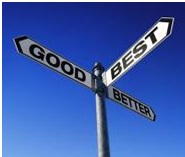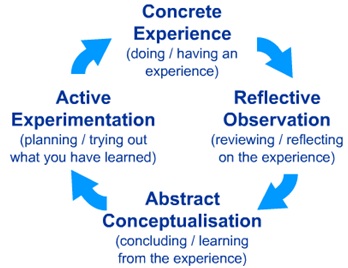|
 |
|
 |
|
|
||
The learning organization
A learning organization is...
An organization where all its employees are continually improving their contribution to its aims (particularly customer satisfaction).
Key questions in learning for people and organizations are:
How to become a learning organization
1. Experience with humility (learning by doing)
David Kolb’s (pictured right) learning cycle looks like:
This shows: a) learn from experience Reflect on your mistakes, failures and successes and learn from them.
b) arrogance stops learning So humility and accepting your own ignorance are vital.
c) practice makes perfect The more you do something, the better you become. The same is true in business – as sales and market experience increase, a business’s costs per product (unit costs) will fall. The Boston Consulting Group’s Law of Experience says that unit costs will fall by a constant percentage (normally 20-30%) every time production and sales double.
2. Employees who learn Their learning can be improved by:
a) understanding the learning curve which identifies four learning stages: 1st - significant improvement. 2nd - little or no progress (the learning plateau during which people need encouragement). 3rd - increasing performance. 4th - decreasing improvement
b) self-motivation Wanting to learn because it’s creative, relevant and achieves something worthwhile.
c) experience (of different tasks and jobs).
d) reflection People should observe, critically evaluate their assumptions and beliefs and then draw conclusions.
e) analysis Examining the pro’s and con’s of particular arguments and situations.
f) physical and mental health (from exercise, relaxation and creativity).
g) continual training and education.
h) experimentation and acceptance of failure (to try and fail is to learn, to fail to try is to miss an opportunity).
i) simplicity New material should be broken down into logical, easy to follow steps, proceeding from the easy to the difficult.
j) variety Using different learning methods and senses (e.g. sight and hearing).
k) feedback (on performance and how to improve).
3. An open, no blame organization Learning needs everyone honestly exchanging information and opinions, however controversial, without fear of criticism, punishment, or blame. This is called a boundaryless organization in which communication and departmental barriers are removed. Nobody should avoid responsibility for a problem by blaming somebody else for it.
4. Inspirational leaders and managers They must:
5. Knowledge creation It’s best to be a knowledge creating organization in which employees continuously learn and create new knowledge by:
An example of a causal loop is low employee motivation leading to... customer dissatisfaction leading to... redundancies leading to... even lower motivation.
6. Make the most of an organization’s intellectual
capital This is also sometimes called the organization’s collective brainpower and has three parts according to Thomas Stewart (pictured right) in his book, Intellectual Capital (1998):
7. Teamwork and empowerment Important to learning are:
8. Learn from people outside
a) benchmarking (learning from the best practices of other organizations). But their advice may become obsolete and their practices may be difficult to copy (particularly those relating to employees and corporate culture). b) strategic alliances (or joint ventures) (partnerships between different companies) For example, the Airbus (pictured right) was made by several European aircraft manufacturers).
c) external stakeholders (particularly customers and suppliers) Listen and respond to what they say.
Key quotes explained
“Dare to know” - Immanuel Kant ,German philosopher (pictured right) This was the motto of the Enlightenment, an incredibly creative period of Western history. Always question everything and seek new knowledge by accepting your own ignorance. “I know nothing except the fact of my ignorance”, the Greek philosopher, Socrates, said. Doubt increases with knowledge, because you become more aware of your ignorance. Learning is also progressive, continually turning heresies into truths, so that “every knowledge eventually becomes the wrong knowledge”, said the American management writer, Peter Drucker.
“Once you stop learning, you start dying” - Albert Einstein, German born American scientist (pictured right) Never stop learning and improving, or, as Stephen Covey puts it in The Seven Habits of Highly Effective People: “Sharpen the
saw”
“Experience teaches” - Tacitus ,Roman historian and politician (pictured right) Learn from what you do (failures as well as successes) and new knowledge that you discover for yourself. “You cannot teach a man anything, you can only help him to find it for himself”, said the Italian scientist, Galileo.
“Test every concept by the question: what sensible difference to anybody will its truth make?” - William James, American psychologist and philosopher (pictured right) Knowledge and learning must be practical and used to create solutions to people’s problems. But knowledge must be based on the right values (e.g. love), or it will be used in the wrong way (e.g. using atomic power to make bombs). “Knowledge without integrity is dangerous and dreadful”, said the English writer, Samuel Johnson.
“An investment in knowledge pays the best interest” - Benjamin Franklin, American inventor and politician (pictured right) Knowledge and lifelong learning are vital to success and dependent on purposeful thought. “Learning without thought is labour lost; thought without learning is perilous”, Confucius said.
Best books and articles
Peter Senge (pictured right) , The Fifth Discipline (1990) Five things (disciplines) make people (and so organizations) learn better:
Chris Argyris (pictured right) and Donald Schön (pictured right below) , Organizational Learning (1978) There are two types of learning:
People don’t learn because they find ways of avoiding new ideas (“defensive routines”) so they don’t have to change. (For more detail see Organizational Learning in the Business Books section)
Roger Bacon (pictured right) , Opus Magus (1267) The English philosopher identifies four causes of ignorance:
Bluma Zeigarnik (pictured right) , The Retention of Completed and Uncompleted Tasks (1927 article) Your memory of a task is improved, if it's interrupted (e.g. by breaks) - called the “Zeigarnik effect”
George Armitage Miller (pictured right) , The Magical Number Plus or Minus Two (1956 article) Your instant memory is limited to seven bits of information (plus or minus two). |
|
|
||
|
|
||
| Copyright © wisdomtowin.com 2025 All Rights Reserved | ||
|























